
© Darian Volkova. (Click image for larger version)
Mariinsky Ballet
Paquita
★★★✰✰
Washington, Kennedy Center Opera House
8, 11 October 2019
mariinsky.ru
www.kennedy-center.org
The Mariinsky Ballet brought to the Kennedy Center Opera House its brand new version of Paquita for a seven-performance run as part of the company’s traditional annual engagement in Washington D.C. This full-length production is a result of collaboration between choreographer Yuri Smekalov and Yuri Burlaka, a 19th-century ballet researcher and prominent reconstruction specialist.
Described in the program notes as “a mark of respect and gratitude of the new ballet generation to the aesthetics of the unsurpassed master of classicism Marius Petipa,” this freshly reinvented Paquita, surprisingly, has little in common with the original production of the ballet that helped launch the career of Petipa at the Mariinsky.
Like Giselle and Le Corsaire, Paquita was born in France, staged by Joseph Mazilir for the Paris Opera Ballet. It premiered in Paris in 1846 with the cast led by Carlotta Grisi in the title role of a spirited gypsy girl and Lucien Petipa (Marius’s brother) in the role of a dashing French officer who wins her heart. It was this 1846 production that traveled to St. Petersburg one year later and was revised by Petipa for the St. Petersburg’s Imperial Ballet. The choreographer was not only responsible for the staging (it was his first full-length production in Russia); he also made his dancing debut as the leading man.
Yet unlike Giselle and Le Corsaire, the full-length Paquita was never a mainstay of the 19th-century ballet repertory. Throughout the 20th-century, only the excerpt from Paquita – its celebratory Grand Pas Classique, which Petipa added to the ballet in 1881 – was popular and performed across the world by numerous ballet companies in various editions.

© Darian Volkova. (Click image for larger version)
In the 21st-century, however, the full-length Paquita has experienced an awakening of sorts, with two notable revivals: by Pierre Lacotte for the Paris Opera Ballet in 2001 and by Alexei Ratmansky and Doug Fullington for the Bavarian State Ballet in 2014. Lacotte’s version attempted to re-create the look and atmosphere of the Mazilir’s rendition; whereas the Ratmansky-Fullington team aimed to bring their version as close as possible to Petipa’s.
That brings us to the Mariinsky’s new staging.
This three-act three-hour-long Paquita is a brainchild of Smekalov, who is a second soloist with the company. He wrote his own libretto, largely borrowing from the Cervantes novella La Gitanilla; created his own choreography for the first two acts; and edited the score – a compilation of the music by Édouard Deldevez, Ludwig Minkus and Riccardo Drigo.
In Smekalov’s version, just like in the original Paquita, the story centers on a beautiful gypsy girl with a secret identity. In the opening Prologue, we see her being kidnapped by a gypsy couple from her family palace; in the two acts that follow, we see her as a fetching street dancer who captivates the heart of a young handsome officer, Andrés. To prove his love for Paquita the young man agrees to travel with the group of gypsies for two years. When a jealous Carducha, who is unable to attract Andres’s love, conceives vengeance and the two lovers end up in prison, after being wrongly accused of theft. But it all ends well. The noble status of Paquita is swiftly discovered and the story culminates with a glorious wedding celebration.
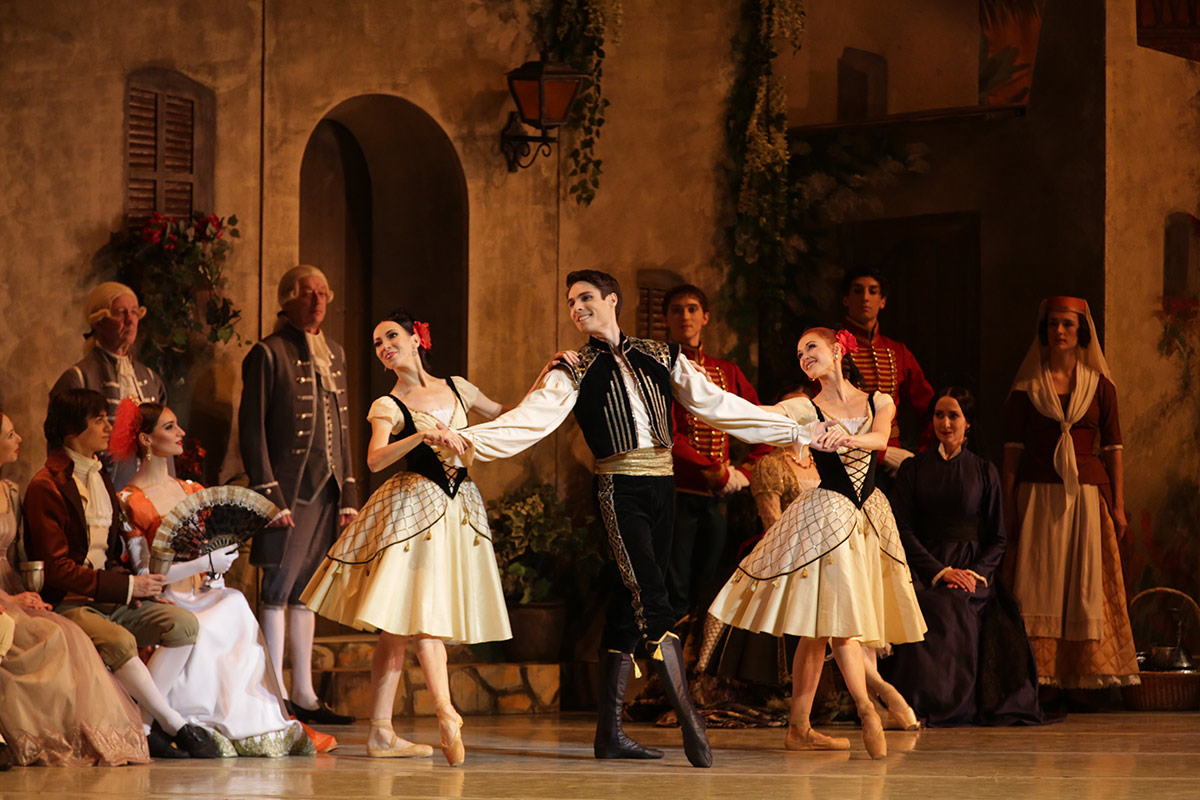
© Darian Volkova. (Click image for larger version)
This Paquita is a production of many charms. The ballet has a picture-perfect look. The stage decorations (by Andrei Sevbo) and the costumes (by Elena Zaitseva) are vibrant, effective and efficient. In the course of the ballet, the stage of the Opera House undergoes a series of “magical” transformations as the action moves from the regal home of Paquita’s parents to a buzzing square in Madrid, to a pastoral setting of the gypsy camp, to the picturesque Inn of a wealthy old woman, to a dingy prison cell, and finally, back to the stately ballroom where the wedding festivities of Act III take place.
Yet, during the first two acts, the ballet rarely spreads its wings. The story drags, often lacking in focus and narrative logic. And Smekalov’s choreography is rarely exciting: being repetitive and overly simplistic, especially for the leads. An intriguing spectacle, with suspense and dramatic tension, it most certainly isn’t.
It’s no surprise then that the third act’s Gran Pas feels like a salvation. It delivers what the audience has been waiting for: a grand sparkling display of classical ballet at its most thrilling. Yuri Burlaka reconstructed Petipa’s choreography for this spectacle using the surviving records of the original 1881 staging; and he did a truly admirable job – the final act provides the Mariinsky dancers with the ample opportunity to showcase their talents and virtuosity, creating onstage a truly festive atmosphere and giving the viewers plenty of reasons to cheer.
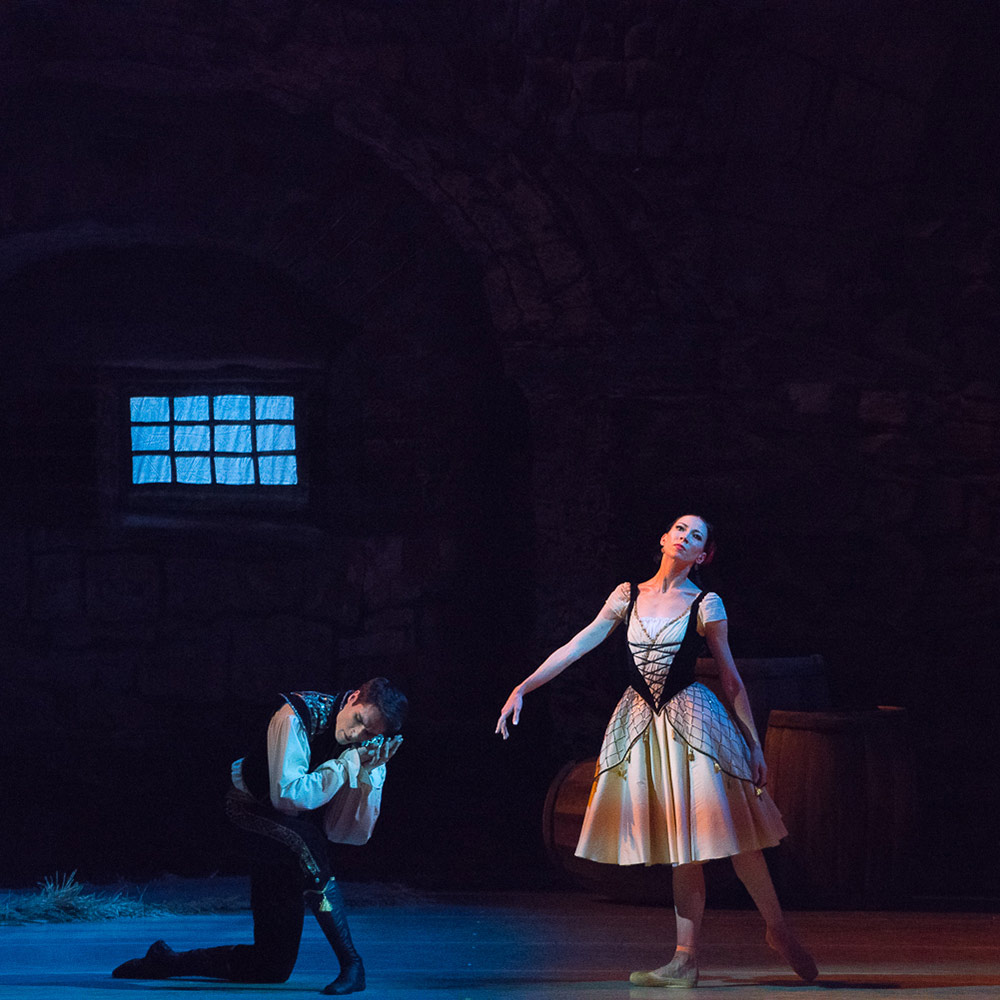
© Darian Volkova. (Click image for larger version)
On opening night, the company’s prima ballerina Viktoria Tereshkina was a confident, proud and poised Paquita. She danced with a mix of elegance and flamboyance, stabbing the floor with her steel pointes in mock flamenco steps and demonstrating her powerful skills and commanding stage presence. The charismatic Timur Askerov, as her lover Andrés, brought to the fore his technical prowess. Yet the audience had to wait until the final act’s Grand Pas to fully appreciate the leading couple’s artistic brilliance.
On Friday night, in the second cast, Maria Khoreva managed to give the ballet its beating heart. To watch her performance in the first two acts is to realize that Paquita is actually a love story. Khoreva’s Paquita was a pure delight: exuberant and captivating, graceful in her movements and enchanting in her manners. Konstantin Zverev was an elegant and magnetic Andrés. His hero looked totally smitten by Khoreva’s heroine, thus infusing the proceedings with a much needed romantic flair.
There were many notable performances from the supporting cast on both nights. Renata Shakirova was alluring and appropriately arrogant in the role of the scheming Carducha; and Vlada Borodulina and Anastasia Nuikina stood out in their solo variations in the Grand Pas on opening night. In the second cast, as Cristina, Maria Shirinkina made a particular impression, dancing with a terrific skill, appealing plasticity and sunny charm.
But the high point of this production – and the audience’s favorite moment – was the final act’s Mazurka de Enfants, danced by the excellent team of students from the Vaganova Academy. Dressed in white and red chic uniforms, they danced their hearts out, articulating every step, every gesture with great precision and flair. Dancing at its most electrifying, it was a true homage to the great ballet master.










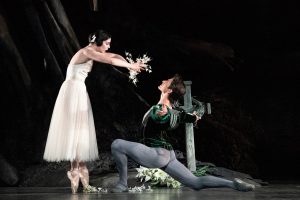
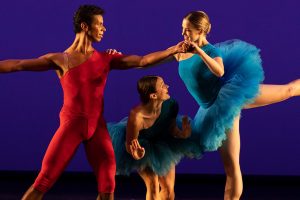
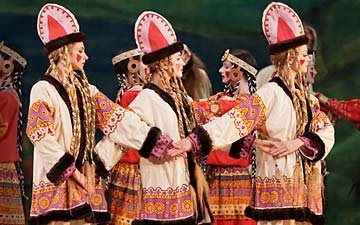


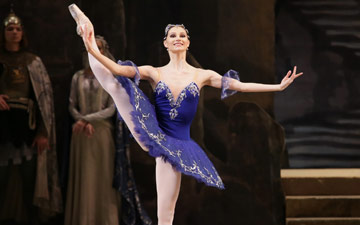

Oksana’s review of Paquita is a lively one. Wikipedia spells the original composer
name as Mazilier, His creditst may well have undergone a change when reaching St. petersburg, thanks to possible Paris Opera intrigues.